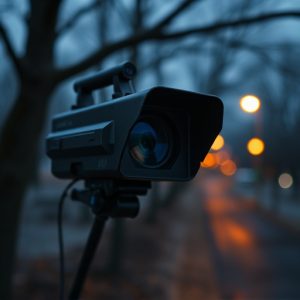Mastering Indoor Security: Optical Sensors & Night Vision Camera Techniques
Wireless Night Vision Security Cameras Indoors revolutionize indoor surveillance with wire-free, 24/…….
Wireless Night Vision Security Cameras Indoors revolutionize indoor surveillance with wire-free, 24/7 monitoring powered by infrared (IR) LED technology. These cameras capture high-resolution footage in low-light conditions, offering discreet and flexible wireless data transmission to smartphone apps for remote monitoring. Professional sensor detection sweeps optimize performance using advanced algorithms, while strategic placement, regular cleaning, and firmware updates ensure optimal image quality and stable connectivity.
Uncover the secrets of enhancing indoor security with the power of Wireless Night Vision Security Cameras. This comprehensive guide explores the cutting-edge technology behind these cameras, delving into the crucial role of optical sensors for optimal performance in low-light conditions. Discover professional methods for sensor detection sweeps, ensuring your camera captures every detail. Learn best practices to optimize night vision capabilities, transforming your indoor spaces with advanced surveillance solutions.
- Understanding Wireless Night Vision Camera Technology
- The Role of Optical Sensors in Indoor Security
- Professional Methods for Sensor Detection Sweep
- Best Practices for Optimizing Night Vision Camera Performance
Understanding Wireless Night Vision Camera Technology
Wireless Night Vision Security Cameras Indoors have revolutionized home and business security by offering advanced surveillance capabilities without the clutter of wires. These cameras utilize infrared (IR) LED technology to capture clear images in complete darkness, ensuring round-the-clock monitoring. The IR LEDs emit light invisible to the human eye but detectable by the camera’s sensor, allowing it to record high-resolution footage even in low-light conditions.
This technology is particularly beneficial for indoor spaces where installing traditional wired cameras might be challenging or aesthetically displeasing. Wireless Night Vision Security Cameras provide a discreet and flexible surveillance solution. They can easily be mounted on walls or ceilings and transmit video data wirelessly to a central monitoring system or a smartphone app, making it convenient to monitor activities from anywhere at any time.
The Role of Optical Sensors in Indoor Security
Optical sensors play a pivotal role in enhancing indoor security, especially when integrated with wireless night vision security cameras. These sensors are designed to detect and monitor movement within enclosed spaces, providing a robust surveillance system that complements traditional security measures. By utilizing advanced optical technology, they can capture clear images even in low-light conditions, ensuring round-the-clock protection without sacrificing visual acuity.
Wireless night vision security cameras, armed with high-sensitivity optical sensors, offer discreet and effective monitoring solutions for homes, businesses, and other indoor environments. Their ability to transmit real-time footage remotely gives homeowners and security professionals an extra layer of peace of mind. This technology is particularly valuable in areas where traditional wiring might be impractical or disruptive, making it a versatile and modern approach to indoor security.
Professional Methods for Sensor Detection Sweep
Professional methods for sensor detection sweep play a crucial role in ensuring optimal performance and accuracy, especially with wireless night vision security cameras indoors. Advanced techniques leverage specialized equipment to meticulously scan and analyze every corner of the monitored area, accounting for factors like light conditions, obstructions, and camera positioning. These methods involve intricate algorithms that process real-time data, enabling swift identification of anomalies or potential security breaches.
One prominent approach involves the use of high-resolution thermal imaging cameras integrated with motion detection software. This technology effectively penetrates darkness, allowing for precise detection of heat signatures, which can indicate the presence of living beings. Additionally, professional sweeps may incorporate radio frequency (RF) signal analysis to track and identify wireless devices, enhancing the overall security posture, particularly in sophisticated indoor environments that require discreet and reliable surveillance solutions like Wireless Night Vision Security Cameras.
Best Practices for Optimizing Night Vision Camera Performance
To optimize the performance of wireless night vision security cameras indoors, begin by ensuring optimal placement. Position the cameras in areas with minimal light obstruction, utilizing existing lighting sources or installing additional lights if necessary. Regular cleaning and maintenance are crucial; dust and debris can significantly impact image quality. Consider using a soft cloth to wipe down the lenses periodically.
Another best practice is calibrating the camera’s settings for optimal sensitivity and resolution. Adjusting the IR intensity and image gain levels ensures clear, detailed footage even in complete darkness. Additionally, keeping firmware up-to-date enhances performance and stabilizes connectivity, ensuring smooth operation of wireless night vision security cameras indoors.
Wireless night vision security cameras indoors have revolutionized indoor security with their advanced optical sensor technology. By understanding the intricacies of this technology, implementing professional methods for sensor detection sweep, and adhering to best practices, users can optimize camera performance, ensuring enhanced indoor security. These strategies are vital in navigating the complex landscape of wireless night vision camera systems, fostering a safer environment through efficient surveillance.


